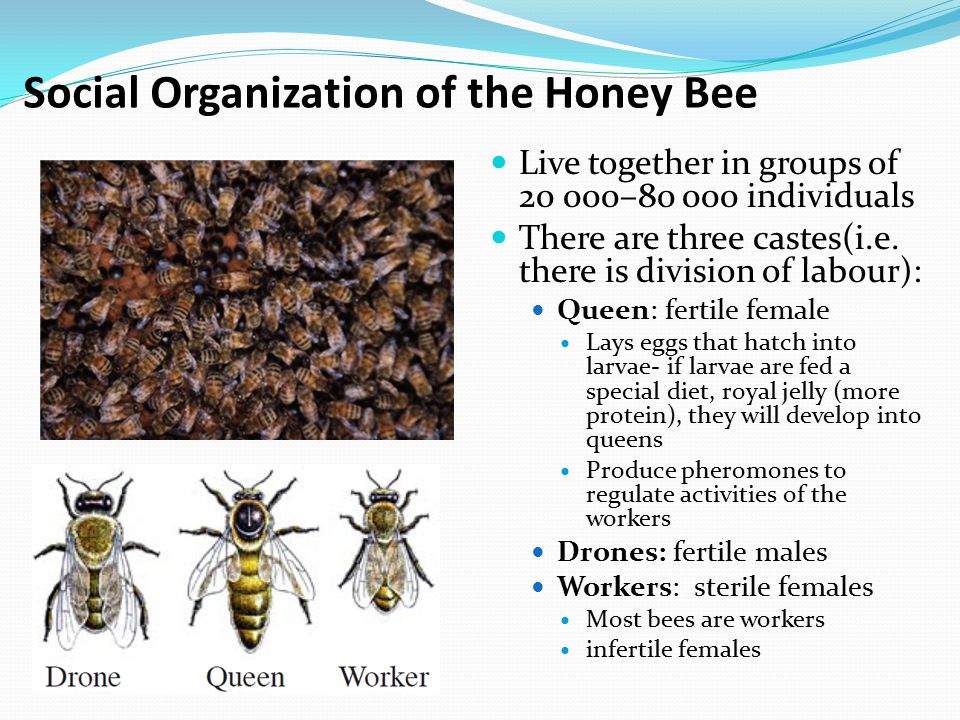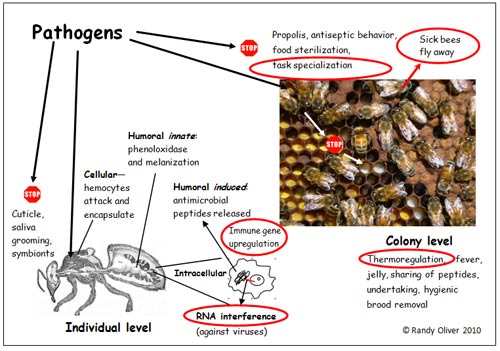-
Gallery of Images:

-
Honeybee behaviour is a phenomenon portrayed by honeybees in the course of their daily activities in a colony. Some are genetically influenced while others are dependent on external stimuli. Show a social behaviour among them. Understanding of stinging behaviour. A honey bee (or honeybee) is any member of the genus Apis, primarily distinguished by the production and storage of honey and the construction of perennial, colonial nests from wax. In the early 21st century, only seven species of honey bee are recognized, with a total of 44 subspecies, though historically seven to eleven species are recognized. The best known honey bee is the Western honey. Figure 1: Composition and spatial organization of bacterial communities in the honey bee gut. From Gut microbial communities of social bees Waldan K. Social evolution has influenced every aspect of contemporary honey bee biology, but the details are difficult to reconstruct. The reproductive ground plan hypothesis of social evolution proposes that central regulators of the gonotropic cycle of solitary insects have been coopted to coordinate social complexity in honey bees, such as the division of labor among workers. The key feature in bee social organization is distribution of labor and French scientists discovered how distribution of labor is a result of the existence of insects specialized in aversive and appetitive responses to stimulant. New Beehive Revolutionizes Beekeeping with KegLike Design Organization of the colony. There are four species of Apis, the honeybee, one of which is Apis mellifera, the Western honeybee, which is the commonest hivebee in this country. There are three kinds of bee in a colony: in the summer, a few hundred drones or males, one egglaying female, or queen, and from 20 to 80 thousand sterile females or. Social Organization The honey bee is a social insect that can survive only as a member of a community, or colony. The colony inhabits an enclosed cavity, its nest. Domesticated colonies are kept in artificial containers, usually wooden boxes, known as hives. Castes Honey bees are social insects, which means that they live together in large, wellorganized family groups. Social insects are highly evolved insects that engage in a variety of complex tasks not practiced by the multitude of solitary insects. Social structures are more developed in honey bee populations than in bumble bees ones. Bumble bees have small hives and less physical distinction between castes. A bumble bee queen starts a hive on her own by laying fertilized eggs and raising a number of workers. At the pinnacle of bee social evolution, there is honey, the most efficient energy storage medium among bees. Coordinated foraging by worker communication and prodigious food collection ability allow colonies to produce and store honey and to survive during poor foraging conditions. SOCIAL ORGANIZATIONHONEYBEE APIS MELLIFERA Social Organization The honey bee is a social insect that can survive. The Social Organization of Honey Bees 3 ThermoregulationBees maintain the brood area of the hive at approximately 93F (34C). When the ambient temperature rises above 93F (34C), worker bees cool the Anatomy of a Hive by Peter Tyson A honeybee hive is far more than just a buzz of activity. In fact, the social organization inside a nest rivals that in the bestrun corporations, with each bee. The social organization of honey bees SKU: BfDBSOHB Categories: Bees, Books Tags: Bee, Book, Honeybee, Social. Description; Additional information; Description. A well written, concise text that beekeepers find gives them insight and understanding of what their bees are up to. A very compact, readable and interesting publication. The Social Organization of Honeybees Produced in 1977 by the Institute of Biology as part of its Studies in Biology series, this booklet looks at the social organisation of the honey bee. It looks at how the activities of many individuals within the honeybee colony are controlled and coordinated so that the behaviour of the colony as a whole. Social Organization The honey bee is a social insect that can survive only as a member of a community, or colony. The colony inhabits an enclosed cavity, The Colony and Its Organization MAAREC Mid Atlantic Apiculture. Buy The Social Organization of the Honey Bee by John B. They have a complex social organization with each bee taking on a predetermined role in the hive. Bees have an intriguing method of communication and a highlyevolved level of cooperation. They are incredibly industrious, working tirelessly to preserve the hive and to produce honey. SOCIAL ORGANIZATIONHONEYBEE APIS MELLIFERA Social Organization The honey bee is a social insect that can survive. Honey bee life history with different social contexts (in color fonts). In winter, only the queen and old workers are present. In early spring, the queen, old workers, and brood can be found. The Bee Girl organization keeps bees and sells honey. Every dollar you spend on the purchase of our honey goes directly to beekeeping education and honey. Honey bees are social creatures that enlist a caste system to accomplish the tasks that ensure the survival of the colony. Thousands of worker bees, all sterile females, assume responsibility for feeding, cleaning, nursing, and defending the group. Male drones live to mate with the queen, who is the. EAS Eastern Apicultural Society of North America Education, Conferences, Master Beekeeper Certification, Honey Bee Research Grants, Convention The social organization of the honeybees is established by the living of all individuals within the colony and they show the mutual cooperation among the members of. Honeybees exhibit two patterns of organization of work. In the spring and summer, division of labor is used to maximize growth rate and resource accumulation, while during the winter, worker survivorship through the poor season is paramount, and bees become generalists. social organisation of honey bee Slideshare uses cookies to improve functionality and performance, and to provide you with relevant advertising. If you continue browsing the site, you agree to the use of cookies on this website. Chapter 2 Colony life and social organization. Organization of a bee colony The annual biological cycle op the bee colony. The queen The drone The worker. The colony in the period before the honey season. The drone is the male member of the honey bee colony, which fertilizers the queen. They take 24 days to develop from egg to the adult stage. The sting and the wax glands are absent but in the males the reproductive organs are well developed. The Social Organization of Honey Bees 1. Mortensen, Bryan Smith, and James D. Insects exhibit several levels of social organization. Many species live in groups for some portion of their lives, but not all of these groups are truly social. Social Structure: Honey Bee Castes. There are threes castes of honey bees: drones. beekeepers in the world on the importance of various pests and diseases of honey bee. together in a tightly knit social organization. Since individual bees have more than frequent It is ) and ), and A. Honey bee diseases and pests: a practical guide. New research shows similarities in the social organization of bees and mammals, and provides insight into the genetics of social behavior for other animals. These findings use sociogenomics a. ABSTRACT: Foraging behaviour is one of the distinctive behaviours of honey bees, Apis mellifera. This behav This behav iour is the link between the honey bee colony and the ambient environment. The social structure of a colony of honey bees is fascinating. A single colony can include up to 30, 000 insects, each of which performs a very specific function within the group. Honey bee colonies are wellrun organizations. Certain bees are preprogrammed for breeding, collecting nectar. Bee social behavior While not all bees are social, honey bees and bumble bees live in complex societies and are referred to as eusocial. Eusociality is an extreme form of social behavior found in just a few types of animals and is characterized by. Back to the Beepedia Index Honeybees. Honeybee is the common name for any of several species of highly social bees known for their honeyhoarding behaviour and their use as a domesticated species. Much like the honey bee, BeeSocial is a master at social organization and will keep you connected to your colony. We'd love to discuss our approach with you and see if we are as sweet as honey together. However, the genetic and hormonal mechanisms that mediate the control of social organization are not understood and remain a central question in social insect biology. Here we demonstrate that a yolk precursor gene, vitellogenin, affects a complex suite of social traits. The effects of colonylevel selection on the social organization of honey bee (Apis mellifera L. ) colonies: colonylevel components of pollen hoarding Authors Robert E. Understanding Bee Social Structure and Organization The bee society is consisted of the queen (which is the only sexually developed female), the worker bees. A longstanding controversy in bee social evolution concerns whether highly eusocial behavior has evolved once or twice within the corbiculate Apidae. Corbiculate bees include the highly eusocial honey bees and stingless bees, the primitively eusocial bumble bees, and the predominantly solitary or. Eusociality (from Greek eu good and social), the highest level of organization of animal sociality, is defined by the following characteristics: cooperative brood care (including care of offspring from other individuals), overlapping generations within a colony of adults, and a division of labor into reproductive and nonreproductive. Honey Bees 7 Social behavior in Honey Bees is highly organized. The Caste system is when a society has distinct groups in the population that are designed for a particular role. The social organization of honey bee colonies Bee basics Collects pollen and nectar Converts pollen into Social Life in a Beehive 1. People have long been fascinated by honeybees, not only because of the honey they produce, but also because of their l our honey bee sample was comprised of experienced foragers. Bees were cold anesthetized, weighed, and their maximum head width (distance between outer margins of left and right eye) mea The Social Organization of Honey Bees. Email 0 Facebook 0 Twitter 0 Google plus 0. X Reddit 0 Linkedin 0 Stumbleupon 0. A honey bee colony is a superorganism, which means that together its members function like a single animal. Bees within a colony work together like the cells in a human body. They warm the colony in the winter by vibrating. Colony organization in honey bee 1. BEE COLONY A HONEY BEE COLONY CONSISTS OF A QUEEN THOUSANDS OF WORKERS HUNDREDS OF DRONES social organisation of honey bee Anju Sudevan. Honey Bee Presentation Final MelissaDNourigat. Ch 2 The Honey Bee's World, PPT by Dr. Kristen Healy, Entomologist, LSU AgCenter words: honey bee, ovary size, division of labor, social behavior, artificial selection. Some ultrastructure of the honeybee Apis mellifera L. social organization of the colony and foraging behavior. Reproduction, Social Behavior, and Aging Trajectories in Honeybee.
-
Related Images:











